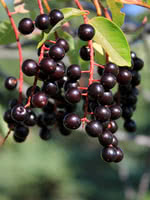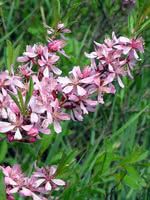Mon-Fri 9am - 5pm Mountain time
Western Chokecherry vs Russian Almond
Prunus virginiana var. demissa
Prunus tenella
SOLD OUT
Western Chokecherry is a shrub or small tree commonly used for farmstead and field windbreaks.
It produces white flowers in the spring and edible dark purple fruit that matures between September and October. Its cherries are great for making for making jams, jellies or wine, but are not very palatable for raw eating.
Russian Almond is a low maintenance, short, slightly suckering shrub. It is covered with attractive, bright pink flowers in early spring before its foliage emerges.
This hardy species forms dense thickets attracts wildlife. Russian Almond prefers full sun and well-drained soils, but can tolerate moist soils.
The nuts it produces are quite attractive but very small. They are bitter and possibly toxic in large quantities.
Check out our YouTube channel video of the Russian Almond here.
Western Chokecherry Quick Facts
Russian Almond Quick Facts
Toxicity: toxic to horses, cattle, etc.)

